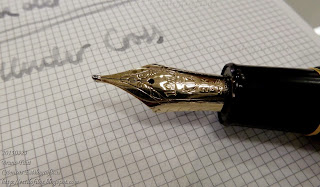(Note added on January 8th: This text has been amended on this date to correct some inaccuracies and eliminate some uncertain data.)
… or how to make a piston with little hassle.
… or the evolutionary ancestors of Conid’s Bulkfiller.
For many, the piston filler, so dear to German makers, is the filling system of choice, however, it does not come without disadvantages, the most clear being the large space needed to harbor the piston mechanism inside the barrel. All that space, needless to say, is dead space in terms of ink capacity. To minimize this problem several technical solutions have been suggested. The better known of which is the
telescopic piston. A more modern strategy is that of
Conid for its Bulkfiller model: a piston whose plunger rod is decoupled from the seal and is stored inside the ink deposit once the filling process had been completed.
Maker Astra tried a similar –but not equal— approach in the early 1940s: the plunger that moves the piston seal up and down in the barrel can be unscrewed from it and removed altogether from the pen. And, in fact, it MUST be removed once the pen was filled up and, therefore, the cork seal was at the top of the ink deposit.
The disadvantage of this system is clear: there is the need to keep the plunger rod stored while the pen is in use. Without it, filling the pen is not possible. But there are advantages too:
If compared to a standard piston, this system clearly takes a lot less space in the barrel and the ink deposit is a lot bigger.
 The closing piece of the barrel has this particular shape to keep the piston seal from rotating and allowing the rod to be unscrewed.
The closing piece of the barrel has this particular shape to keep the piston seal from rotating and allowing the rod to be unscrewed.
If compared to the Bulkfiller by Conid, the metal rod is not in contact at all with the ink, and there is not need to create any seal between the rod and the seal itself. In the Bulkfiller, the rod literally moves across the piston seal, and there can be leaks through seal along the rod.
 The engraving on the nib reads "DURFLEX / FPT / 4 / EXTRA".
The engraving on the nib reads "DURFLEX / FPT / 4 / EXTRA".
As for the rest of the pen, the Astra is made of ebonite (section) and celluloid (barrel), and implements a steel nib. The dimensions of the pen are as follows:
Length closed: 124 mm
Length open: 116 mm
Length posted: 151 mm
Diameter: 12 mm (barrel)
Weight (dry): 15.5 g
Ink deposit: 2.5 ml.
No filling system is perfect, and this “detachable plunger” is no exception, but there are great advantages to it. The large ink capacity is indeed a powerful argument on its side.
It is not clear where this Astra pen was made. The inscription on the nib suggest an Italian origin. As an anonymous commentator pointed out, Durflex was the brand of the Pecco brothers, and FPT meant "Fratelli Pecco Torino". The owner of the pen bought it at a flea market in Warsaw, and a selling argument was that Polish soldiers used this pen during the Second World War and kept the detachable rod in their breast pocket. Probably an exaggerated claim... Any information on the origin of the brand Astra would be gladly appreciated.
Very special thanks to KDENA.
Inoxcrom Corinthian – Sailor Yama-dori
Bruno Taut
Madrid, December 19th, 2015. Nakano, January 8th, 2016.
etiquetas: Astra, Conid, soluciones técnicas






























































